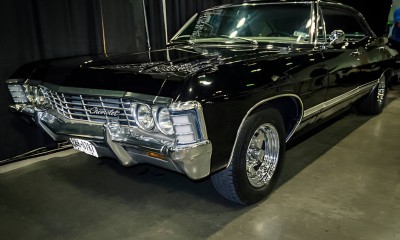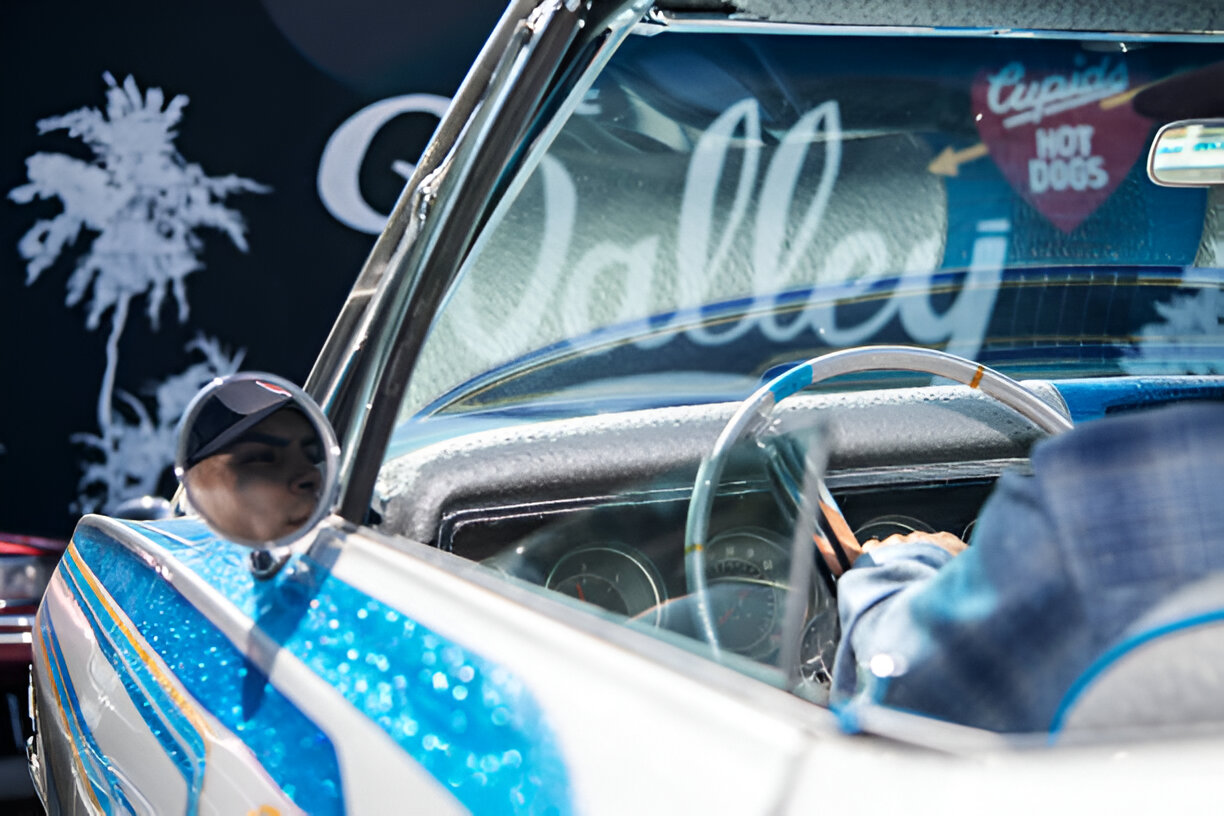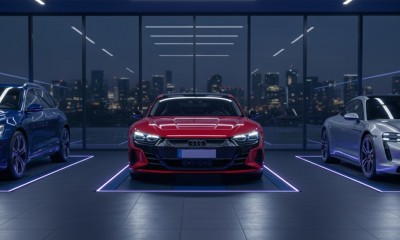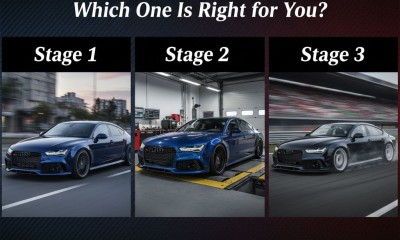1967 Chevrolet Impala: From Classic Muscle Icon to Ultimate Tuning Platform

The 1967 Chevrolet Impala stands as a high-water mark in American automotive design and a cultural touchstone that continues to resonate with enthusiasts worldwide. More than just a full-size family car, it represented the pinnacle of an era, blending style, accessibility, and formidable performance. To understand its enduring appeal and its evolution into a premier tuning platform, one must first examine the steel, chrome, and raw power that defined it from the factory floor.
A Legacy Cast in Steel: The Zenith of "Coke Bottle" Design
As a key model in the Impala's fourth generation (1965-1970), the 1967 version received a significant facelift that refined its already popular shape. Designers exaggerated the "Coke bottle" styling, a hallmark of 1960s automotive aesthetics, with pronounced front and rear fender bulges and a distinctive pinch line along the top. The two-door Sport Coupe featured a particularly graceful fastback roofline that flowed in an unbroken line to the rear deck, creating a sleek and powerful silhouette. This design language solidified the Impala's position not just as transportation, but as a statement of style.
The 1967 model year also marked a turning point in automotive safety. In keeping with new federal regulations, Chevrolet integrated several key safety features, including a fully collapsible energy-absorbing steering column, side marker lights, and shoulder belts for closed models. These additions, while standard today, were advanced for the time and signaled a shift in industry priorities.

Despite its sporty appearance, the Impala remained Chevrolet's versatile bestseller, offered in a wide array of body styles to suit every need. The lineup included two- and four-door hardtops, a four-door sedan, a convertible, and six- and nine-passenger station wagons. This versatility, combined with its stylish looks, helped Chevrolet sell over 575,000 Impalas in 1967, cementing its place as a dominant force in the market.
Under the Hood: Analyzing the Original V8 Powerplants
The heart of the 1967 Impala's appeal, particularly for performance enthusiasts, was its diverse and potent engine lineup. While a base 155 horsepower 250 cubic-inch (CID) Turbo-Thrift inline-six was available, the V8 options are what defined its muscle car credentials. The standard V8 was the reliable 195 horsepower 283 CID Turbo-Fire, but the option list provided a clear path to serious performance.
Buyers could upgrade to the L30 327 CID V8, producing a healthy 275 horsepower, or step up to big-block power with the L35 396 CID Turbo-Jet V8, rated at 325 horsepower. The top-tier performance option was the formidable L36 427 CID Turbo-Jet V8. This engine, included in the coveted SS 427 package, produced 385 horsepower and a massive 460 lb-ft of torque, enough to move the full-size car with startling authority. It's a crucial detail for purists that the even more powerful 425 horsepower L72 427 V8, available in other Chevrolet models, was not offered in the full-size lineup for 1967.
Power was routed through a selection of transmissions, including a standard 3-speed manual, an optional 4-speed manual for V8s, the 2-speed Powerglide automatic, and the robust 3-speed Turbo-Hydramatic automatic, which was newly available for the 327 V8 in addition to the big-blocks.
|
Engine Designation |
Displacement (CID) |
Horsepower (HP) |
Torque (lb-ft) |
Carburetor |
Compression Ratio |
|
Turbo-Thrift I-6 |
250 |
155 @ 4200 RPM |
235 @ 1600 RPM |
1-Barrel |
8.5:1 |
|
Turbo-Fire V8 |
283 |
195 @ 4800 RPM |
285 @ 2400 RPM |
2-Barrel |
9.25:1 |
|
Turbo-Fire V8 (L30) |
327 |
275 @ 4800 RPM |
355 @ 3200 RPM |
4-Barrel |
10.5:1 |
|
Turbo-Jet V8 (L35) |
396 |
325 @ 4800 RPM |
410 @ 3200 RPM |
4-Barrel |
10.25:1 |
|
Turbo-Jet V8 (L36) |
427 |
385 @ 5200 RPM |
460 @ 3400 RPM |
4-Barrel |
10.25:1 |
Beyond the Factory Floor: The Supernatural Effect and Cultural Immortality
While the 1967 Impala was always a respected classic, its ascent to true cultural immortality was supercharged by a very specific television appearance. The car became a central character, affectionately known as "Metallicar," in the long-running TV series Supernatural. The show featured a black, four-door 1967 Impala Sport Sedan, passed down from father to sons, serving as their steadfast companion, mobile home, and, crucially, their armory.
The show's creator, Eric Kripke, specifically chose the '67 Impala over more conventional muscle cars like the Ford Mustang. He was convinced by a neighbor that the Impala's intimidating presence and cavernous trunk—perfect for stashing a vast arsenal of supernatural-hunting weapons—made it the ideal choice.
This starring role created a unique market dynamic. It elevated the four-door sedan, a body style typically overlooked by collectors in favor of two-door hardtops and convertibles, to iconic status. The show cultivated a new generation of enthusiasts more focused on creating reliable, high-performance tribute cars than on period-correct, numbers-matching restorations. This audience, driven by a desire to experience the "Metallicar" fantasy, is the ideal demographic for modern powertrain conversions that offer V8 power with everyday usability. The demand has dramatically inflated the value of these sedans, with pristine examples commanding prices up to $50,000, far exceeding comparable models from the era.
The Art of Analog Power: Traditional Tuning for the '67 Impala
Before the advent of digital engine management, extracting more power from a 1967 Chevrolet Impala was a mechanical art form. It involved a hands-on, iterative process of adjusting fuel delivery, spark timing, and engine airflow using physical components. Understanding these traditional methods provides a crucial baseline for appreciating the quantum leap in precision and control offered by modern tuning solutions.
Mastering the Mixture: A Guide to Carburetor Tuning
The carburetor is the mechanical heart of the classic V8's fuel system. Tuning it correctly is fundamental to performance. The process involves manually adjusting various circuits to achieve the optimal air-fuel ratio under different operating conditions. For many Impala owners, upgrading from the factory Rochester carburetor to a more tunable aftermarket unit from a brand like Holley or Edelbrock is a common first step.
Tuning a Holley-style carburetor, for example, is a multi-step process:
-
Set Fuel Pressure and Float Level: The process begins by ensuring the correct fuel pressure (typically 6-6.5 psi) is delivered to the carburetor and that the fuel level inside the float bowls is set correctly to prevent flooding or starvation.
-
Adjust Idle Mixture Screws: With the engine warm, the idle mixture screws are adjusted in small increments while monitoring a vacuum gauge. The goal is to achieve the highest possible vacuum reading, known as the "lean-best" idle setting, which provides a smooth idle and good fuel efficiency.
-
Select Power Valve: The power valve enriches the fuel mixture under heavy load (low vacuum). The correct valve is chosen based on the engine's vacuum reading at idle, typically half the value of the idle vacuum.
-
Change Jets and Metering Rods: The main jets (and metering rods in an Edelbrock) control the air-fuel ratio during cruising and wide-open throttle. Swapping these for different sizes is how tuners dial in the main fuel curve, a process often guided by reading the color of the spark plugs after a test run.
This entire process is a system of disconnected, analog compromises. Each adjustment is made in relative isolation, and optimizing one parameter can have unintended consequences for another. There is no central "brain" to orchestrate these functions in real-time, relying instead on the tuner's skill and experience.
The Rhythmic Spark: Dialing in Ignition Timing
Working in concert with the carburetor is the ignition system, controlled by the distributor. The distributor's job is to send a high-voltage spark to each cylinder at precisely the right moment to ignite the air-fuel mixture. Setting the base ignition timing with a timing light is the first step. However, the real art lies in tuning the "advance curve." The distributor uses a combination of spinning weights (centrifugal advance) and a vacuum canister (vacuum advance) to advance the timing as engine RPM and load change. Modifying the springs on the weights and adjusting the vacuum canister allows a tuner to tailor this curve, ensuring the spark occurs at the optimal time for maximum power without causing engine-damaging detonation.
Mechanical Heartbeat: Camshaft and Valvetrain Upgrades
The most profound way to change the character of a classic V8 is by swapping the camshaft. The camshaft's lobes dictate when the intake and exhaust valves open and for how long, effectively defining the engine's RPM range and personality. A more aggressive "performance" camshaft can dramatically increase horsepower but may result in a rougher idle and reduced low-end torque. Installing a new camshaft necessitates a complete re-tuning of both the carburetor and ignition timing to match the engine's new breathing characteristics.
The Modern Evolution: Restomodding the 1967 Chevrolet Impala
While traditional tuning methods hold a certain nostalgic appeal, the modern era has ushered in a new philosophy for classic car ownership: the restomod. This approach seeks to blend the timeless aesthetics of a vehicle like the 1967 Impala with the performance, reliability, and comfort of a modern car. This evolution is driven by powerful technologies that transform the classic driving experience.
Bridging Eras: The "Restomod" Philosophy
A restomod is more than a restoration; it's a reinvention. The goal is to create a classic car that can be driven and enjoyed regularly, even daily, without the compromises inherent in 1960s technology. The key benefits that drive this trend are clear :
-
Dramatic Power Gains: Modern engines produce significantly more horsepower and torque than their vintage counterparts.
-
Improved Drivability: Fuel injection provides crisp throttle response, easy cold starts, and smooth operation.
-
Enhanced Reliability: Modern powertrains require far less maintenance and are built to last for hundreds of thousands of miles.
-
Better Fuel Economy: Despite the higher power output, modern engines are substantially more fuel-efficient.
The Heart Transplant: A Deep Dive into the LS Engine Swap
The cornerstone of the modern restomod movement is the General Motors LS engine family. First introduced in the 1997 Corvette, the LS series has become the undisputed king of engine swaps for its incredible combination of power, light weight, compact size, and vast aftermarket support. Swapping an LS V8 into a 1967 Impala is a transformative upgrade.
The process, however, is a comprehensive system overhaul, not just a simple engine replacement. The decision to undertake an LS swap represents a fundamental shift for the vehicle owner—from being a mechanical caretaker to becoming a systems integrator. Success hinges not just on bolting in parts, but on ensuring a complex network of digital and electronic components works in harmony. Key components of the swap include:
-
Engine and Transmission: Popular choices range from cost-effective 5.3L and 6.0L truck engines to high-performance variants like the LS3. These are typically paired with modern electronically controlled automatic transmissions like the 4L60E or 4L80E, which require a computer to function.
-
Mounts and Oil Pan: Custom engine mount adapters are required to bolt the LS block to the Impala's frame. A special rear-sump oil pan is also necessary to clear the car's steering linkage, which sits behind the front crossmember.
-
Fuel System: The original low-pressure fuel system must be completely replaced with a high-pressure Electronic Fuel Injection (EFI) system, typically featuring an in-tank electric fuel pump capable of supplying the 58 psi required by the LS engine.
-
Cooling System: An upgraded aluminum radiator with electric cooling fans is a necessity. The LS engine's serpentine belt system does not have a provision for a mechanical fan, so computer-controlled electric fans are required for proper cooling.
-
Electronics: This is the most critical element. An LS engine cannot run without an Engine Control Unit (ECU) and a dedicated wiring harness to connect the ECU to the engine's sensors, injectors, and coil packs.
EFI Conversion: Bringing Digital Precision to Classic Iron
For owners who wish to retain their Impala's original numbers-matching V8, an EFI conversion kit offers a powerful alternative to a full engine swap. Systems like the Holley Sniper or FiTech Go EFI are designed as direct replacements for the carburetor. These throttle body injection (TBI) units look similar to a carburetor but contain fuel injectors and a host of sensors. They are controlled by a dedicated ECU and use feedback from an oxygen sensor in the exhaust to self-tune the fuel map in real-time, delivering the drivability and efficiency benefits of modern fuel injection to the classic engine.
|
Feature |
Traditional Carburetion |
Modern Standalone EFI |
|
Fuel Delivery |
Mechanical via jets, venturis, and needles |
Digital pulse-width modulation via injectors controlled by ECU map |
|
Ignition Control |
Mechanical/vacuum advance via distributor |
Digital via ECU map controlling individual coil packs |
|
Air/Fuel Ratio Control |
Fixed, based on mechanical settings; requires manual re-jetting |
Real-time, closed-loop adjustment via wideband O2 sensor feedback |
|
Cold Start/Drivability |
Requires manual choke; can be temperamental |
Automated enrichment tables for fast, reliable starts and smooth operation |
|
Altitude/Weather Comp. |
Poor; requires manual re-tuning for significant changes |
Automatic compensation via MAP and IAT sensors |
|
Data Logging |
None |
Comprehensive, real-time logging of all engine sensors |
|
Real-Time Tuning |
Not possible; requires engine shutdown for most changes |
Instant, live changes to fuel and ignition maps via laptop |
|
Adaptability to Mods |
Requires complete manual retuning of carb and distributor |
Easily adaptable by modifying the software tune file |
Unlocking a Legend's Full Potential: The Critical Role of ECU Tuning
Installing a modern LS engine or an EFI system into a 1967 Impala provides the hardware for incredible performance. However, that hardware is dormant without the sophisticated software needed to control it. This is where the Engine Control Unit (ECU) and, more importantly, the custom tuning file loaded onto it, become the keys to unlocking the vehicle's true potential.
The Digital Brain: Understanding the Standalone ECU
A standalone ECU is a powerful, fully programmable aftermarket computer that replaces the factory unit from the donor vehicle. While it's possible to reprogram a factory GM ECU, a standalone system is almost always the superior choice for a custom swap. Factory ECUs are deeply integrated with the donor vehicle's specific chassis, emissions equipment, and anti-theft systems, making them notoriously difficult to adapt to a vintage car.
A standalone ECU, such as a(https://www.lsxmag.com/tech-stories/holleys-terminator-x-vs-gm-standalone-ecu-for-ls-swaps/) or a FiTech Ultimate LS, provides a clean slate. It gives the tuner complete and total control over every aspect of the engine's operation, from fuel and spark to idle control and transmission shifting. The value of a professional tuning file provider lies in their ability to translate a unique and complex hardware combination into a cohesive, optimized digital instruction set. The service is not merely selling a file; it's delivering expertise, safety, and the full realization of the hardware's potential.
The Science of Performance: How Custom ECU Tuning Files Work
The "tune" is the set of data tables, or maps, within the ECU that acts as the engine's brain. A custom tuning file precisely calibrates these maps for a specific vehicle's hardware combination.
-
Calibrating Fuel Maps: The primary fuel table is a 3D map with axes for engine speed (RPM) and engine load (typically manifold absolute pressure, or MAP). The tuner fills in every cell of this table with a value that commands the precise amount of fuel to be injected to achieve the target air-fuel ratio (AFR). This ensures lean, efficient mixtures for cruising and safe, powerful rich mixtures under full throttle.
-
Optimizing Ignition Tables: Similar to the fuel map, the ignition table commands the precise moment the spark plug fires for every RPM and load condition. The goal is to create the maximum amount of cylinder pressure just as the piston begins its power stroke, generating the most torque possible without inducing harmful engine knock or detonation.
-
Fine-Tuning Drivability: Beyond power, a custom tune dials in dozens of other parameters that define the driving experience. This includes setting idle speed control for a smooth idle with an aggressive camshaft, programming electric fan activation temperatures, and, for modern automatic transmissions, controlling shift points, shift firmness, and torque converter lockup behavior.
Why a Generic "Base Map" Is Not Enough
Standalone ECUs come with "base maps" designed only to get a generic engine to start and run safely. They are not optimized for performance. Every restomod project is a unique ecosystem of parts—a specific camshaft, intake manifold, header design, and exhaust system. This unique combination results in a specific volumetric efficiency curve that a generic map cannot possibly account for. A custom, dyno-developed tuning file from a professional service like
HP Chiptuningfiles is the only way to perfectly match the software to the hardware, ensuring maximum power, safety, and drivability from your investment.
|
Tuning Stage |
Description |
Peak Horsepower Gain (Est.) |
Peak Torque Gain (Est.) |
Key Parameters Adjusted |
|
Stock 5.3L w/ Base Map |
Baseline for a junkyard 5.3L LS engine running on a generic startup tune. |
~320 HP |
~335 lb-ft |
Basic startup parameters only |
|
Stage 1 Custom Tune |
Optimized for a stock engine with upgraded headers, exhaust, and cold air intake. |
+25-35 HP |
+20-30 lb-ft |
Fuel & Ignition Maps, Torque Management, Fan Temps |
|
Stage 2 Custom Tune |
Optimized for an engine with a performance camshaft, headers, intake, and exhaust. |
+50-70 HP |
+40-50 lb-ft |
Fuel & Ignition Maps, Idle Control, Transmission Shift Points, VVT/AFM Delete |
HP Chiptuningfiles: Your Partner in Classic Car Modernization
The journey of transforming a 1967 Chevrolet Impala from a carbureted classic into a fuel-injected powerhouse is a testament to automotive passion. This complex integration of mechanical hardware and sophisticated electronics requires a final, critical element to achieve perfection: a professionally engineered ECU tune. At HP Chiptuningfiles, we specialize in providing that final piece of the puzzle.
Precision Engineering for Iconic Machines
We honor the legacy of iconic vehicles like the Impala by applying the highest standards of modern engineering. Our team of experts develops custom, dyno-tested tuning files that are precisely calibrated for complex engine swaps and restomod applications. We understand the unique demands of putting a modern powertrain into a classic chassis and have the experience to optimize every parameter for peak performance and reliability. Explore our extensive tuning file database to see what we offer.
Empowering Professional Tuners and Workshops Worldwide
For professional tuning shops and classic car builders, partnering with HP Chiptuningfiles is a strategic advantage. Our B2B service provides you with access to a vast library of professionally developed and tested files, saving you countless hours of research, development, and dyno time. This allows you to deliver exceptional results to your clients efficiently and confidently, tackling ambitious restomod projects with a trusted partner in your corner. We provide the software expertise so you can focus on the build.
-
Ready to streamline your tuning process? Create a free account today to explore our B2B portal and pricing.
-
Looking for the right tools for the job? Browse our selection of professional tuning hardware.
-
Have a unique Impala project with specific needs? Contact our expert support team to discuss a fully custom file solution.
Frequently Asked Questions (FAQ)
Q1: Can you put an LS engine in a 1967 Impala? A1: Yes, swapping an LS engine into a 1967 Chevy Impala is a very popular and well-supported modification. It requires specific parts like engine mount adapters, a rear-sump oil pan, an upgraded fuel system, and a standalone ECU, but it dramatically improves the car's performance, reliability, and drivability.
Q2: What engine came in a 1967 Impala SS 427? A2: The 1967 Impala SS 427 came standard with the L36 Turbo-Jet V8 engine. This 427 cubic-inch big-block was rated at 385 horsepower and 460 lb-ft of torque. It featured a
10.25:1 compression ratio and was a formidable performance option for Chevrolet's full-size line.
Q3: How much horsepower can you get from a 1967 Impala? A3: A stock 1967 Impala's horsepower ranged from 155 hp for the six-cylinder to 385 hp for the 427 V8. With modern restomodding, such as an LS engine swap and a custom ECU tune, horsepower can easily exceed 400-500 hp for a naturally aspirated setup. Builds using forced induction, like a turbocharger or supercharger, can achieve 800-1000 hp or more.
Q4: Do I need a special ECU tune for an LS-swapped classic car? A4: Absolutely. A generic base map will only get the engine running. A custom ECU tune is essential to optimize the air-fuel ratio and ignition timing for your specific combination of parts (camshaft, intake, exhaust), ensuring you get the most power safely and reliably. This is especially true for a non-standard application like an LS engine in a classic Impala chassis.
Other news and updates

Read more OBD Breakthrough: Tuning Support for the Continental ASG1 ECU in Audi e-tron & Porsche Taycan
The Continental ASG1 ECU used in the Audi e-tron and Porsche Taycan is now fully supported for OBD read/write. This breakthrough allows safe tuning of torque limits, current maps, thermal strategies and pedal response, enabling measurable performance gains whi...
Read more

Read more Stage 1, Stage 2, and Stage 3 Tuning: Which One Is Right for You? | HP Chiptuning Files Europe & UK
Discover the differences between Stage 1, Stage 2, and Stage 3 tuning. Learn which remap is best for your car, driving style, and budget at hp-chiptuningfiles.com.
Read more

Read more Mercedes-AMG G63 2025: ECU Remap & Performance Boost
Hey, we are HP Chiptuningfiles – Europe’s leading ECU tuning file service provider. We deliver custom, dyno-tested tuning files for diesel, petrol & hybrid engines, trusted by 4,000+ clients worldwide. The 2025 Mercedes-AMG G63 combines iconic G-Class ruggedne...
Read more